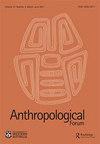Alterity and the Asymmetric Gaze: Aboriginal Constructions of Self and Other in Northwest Arnhem Land
IF 0.7
3区 社会学
Q3 ANTHROPOLOGY
引用次数: 2
Abstract
ABSTRACT While there is much scholarship deconstructing ‘mainstream’ Australian perceptions of Aboriginal and Torres Strait Islander people, there has been little attention to how Aboriginal and Torres Strait Islander peoples perceive non-Indigenous Australians. Yet such perceptions are telling of cultural difference and the circulation of power in a neo-colonial state. In this paper, we focus on Bininj/Yol people in and around the remote town of Maningrida in the Northern Territory, where the term ‘Balanda’ denotes non-Indigenous Australians, particularly of European descent. Exploring themes of work, time, material accumulation, and Country, we ask how Bininj/Yol people construct Balanda; how their understandings of Balanda shape their understandings of Self and vice versa; and how their constructions of Self are refracted through Balanda discourses about Aboriginality. Bininj/Yol portraits of Balanda are seldom flattering and frequently serve as a counterpoint to local Aboriginal ideals of Self. Balanda seem bafflingly deficient in traits proper and natural: they flout appropriate relations with other people, land and cosmos, and appear obsessed with work, clock time, rules, and material accumulation. Drawing on the concept of the gaze as a force that both objectifies and subjects, we then consider the influence of asymmetric ‘looking relations’ on local Aboriginal senses of Self. This was especially apparent during the Northern Territory ‘Intervention’ when the people of the Maningrida region suddenly saw themselves through Balanda eyes, and beheld a shockingly different image than the one they held of themselves.另类与不对称凝视:西北阿纳姆地原住民的自我与他者建构
虽然有很多学术研究解构了澳大利亚人对土著和托雷斯海峡岛民的“主流”看法,但很少有人关注土著和托雷斯海峡岛民如何看待非土著澳大利亚人。然而,这样的看法说明了一个新殖民国家的文化差异和权力流转。在本文中,我们将重点放在北领地偏远城镇马宁里达及其周围的比宁人/尤尔人身上,在那里,“巴兰达”一词表示非土著澳大利亚人,特别是欧洲血统。探索工作、时间、物质积累和国家的主题,我们询问Bininj/Yol人如何构建Balanda;他们对巴兰达的理解如何塑造了他们对自我的理解,反之亦然;以及他们的自我建构是如何通过巴兰达关于土著的话语折射出来的。Bininj/Yol对Balanda的肖像很少奉承,而是经常作为当地原住民自我理想的对位。巴兰达似乎莫名其妙地缺乏适当和自然的特征:他们蔑视与其他人、土地和宇宙的适当关系,似乎痴迷于工作、时钟时间、规则和物质积累。根据凝视作为一种既物化又主体的力量的概念,我们考虑了不对称的“注视关系”对当地土著自我意识的影响。这一点在北领地“干涉”期间尤其明显,当时马宁里达地区的人们突然通过巴兰达的眼睛看到了自己,看到了一个与他们所持有的自己截然不同的形象。
本文章由计算机程序翻译,如有差异,请以英文原文为准。
求助全文
约1分钟内获得全文
求助全文
来源期刊

Anthropological Forum
ANTHROPOLOGY-
CiteScore
3.60
自引率
10.00%
发文量
14
期刊介绍:
Anthropological Forum is a journal of social anthropology and comparative sociology that was founded in 1963 and has a distinguished publication history. The journal provides a forum for both established and innovative approaches to anthropological research. A special section devoted to contributions on applied anthropology appears periodically. The editors are especially keen to publish new approaches based on ethnographic and theoretical work in the journal"s established areas of strength: Australian culture and society, Aboriginal Australia, Southeast Asia and the Pacific.
 求助内容:
求助内容: 应助结果提醒方式:
应助结果提醒方式:


